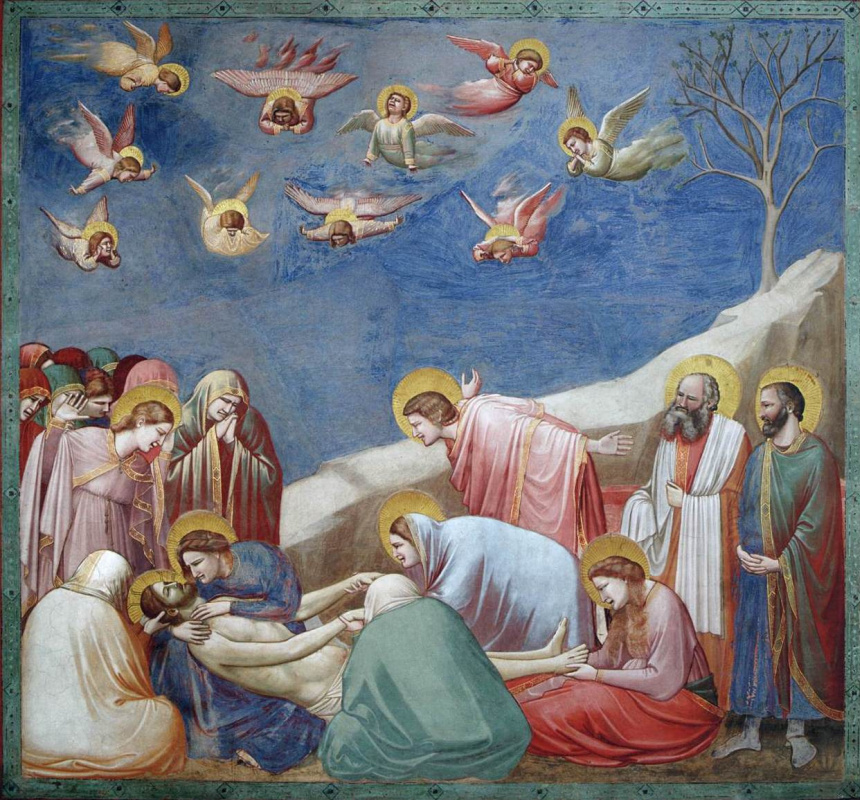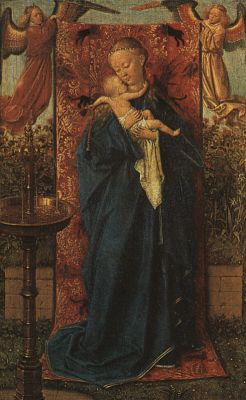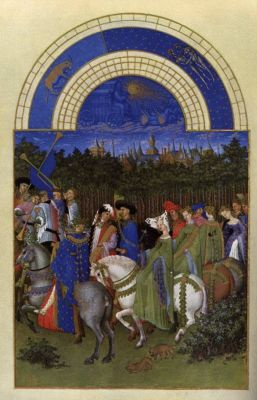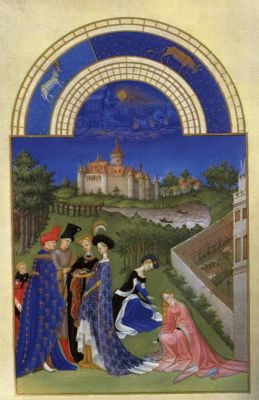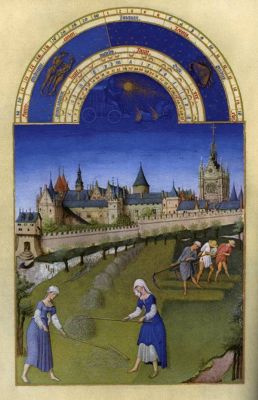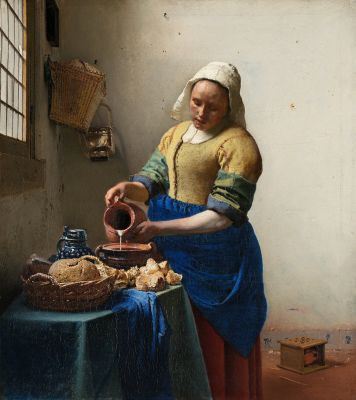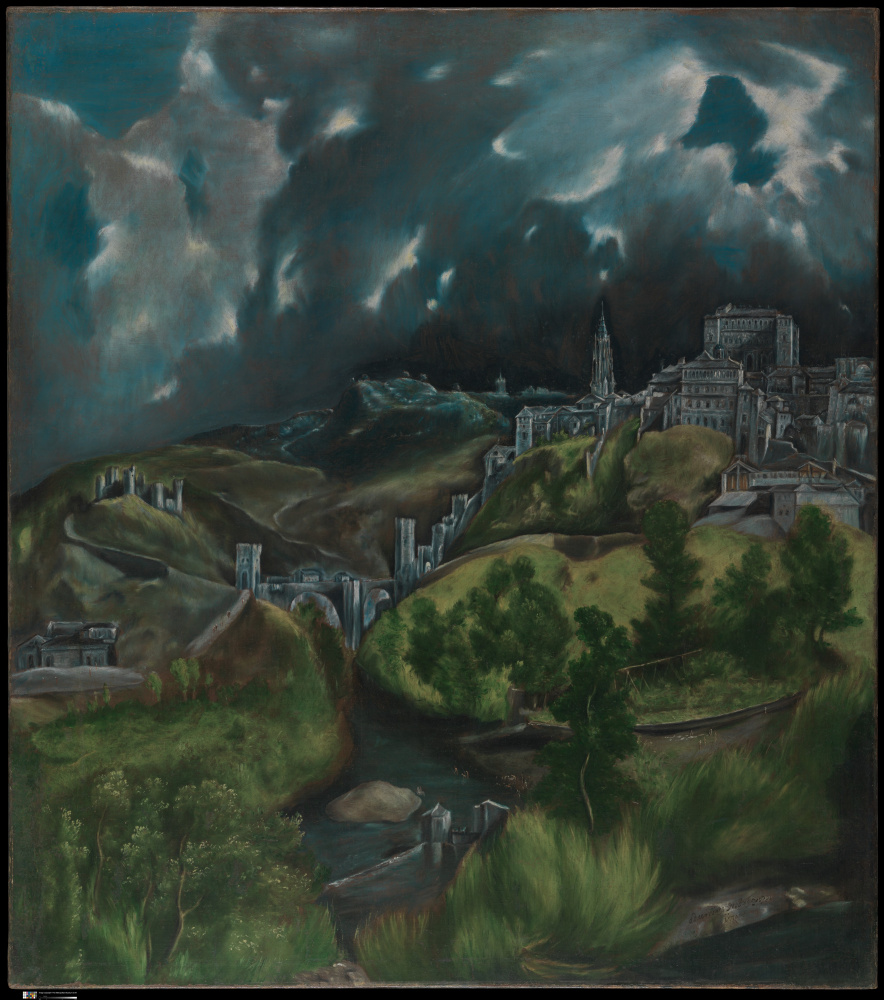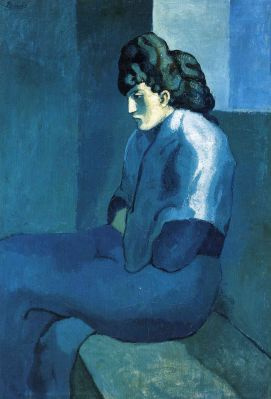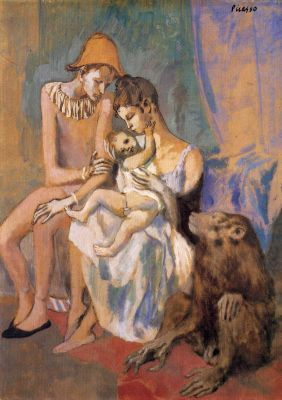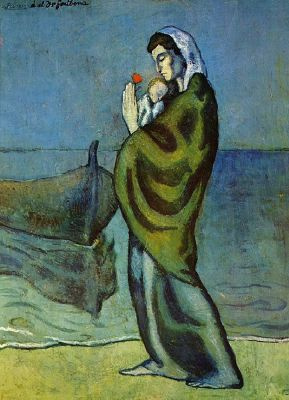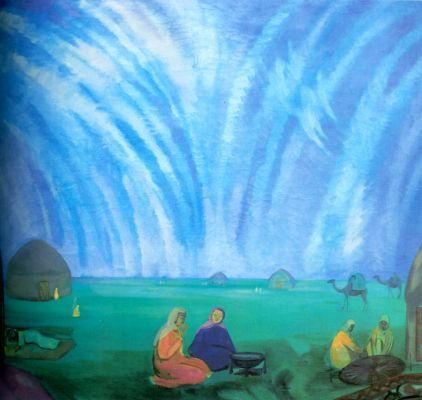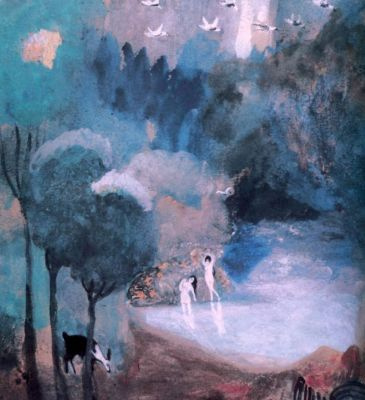Any color is good if used by a master. Now we accept opulent colors in painting as typical, though the same technique has not always been applied. It was not long since beautiful blue has become appreciated in the iconography. Let’s examine all hues of blue from its symbolic point of view.
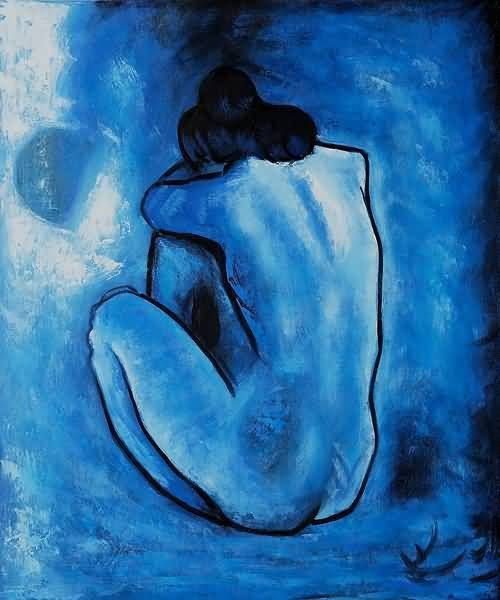
Has blue color ever existed?
Blue colors of the sky and water currently admired by a lot of aesthetes was not always in favor: ancient Greeks and Romans did not distinguish them much. That was the point of view of the philosophers of the XVIII century pointing out that these colors could be met quite rarely in the ancient art and most importantly in the Latin and ancient Greek languages. Moreover, according to the sources, Romans associated a blue color with the barbarian tribes of Germans and Celts decorating their bodies with blue colors for threatening their enemies. Probably because of that reason people hated clothes in blue colors, moreover, a blue color symbolized mourning.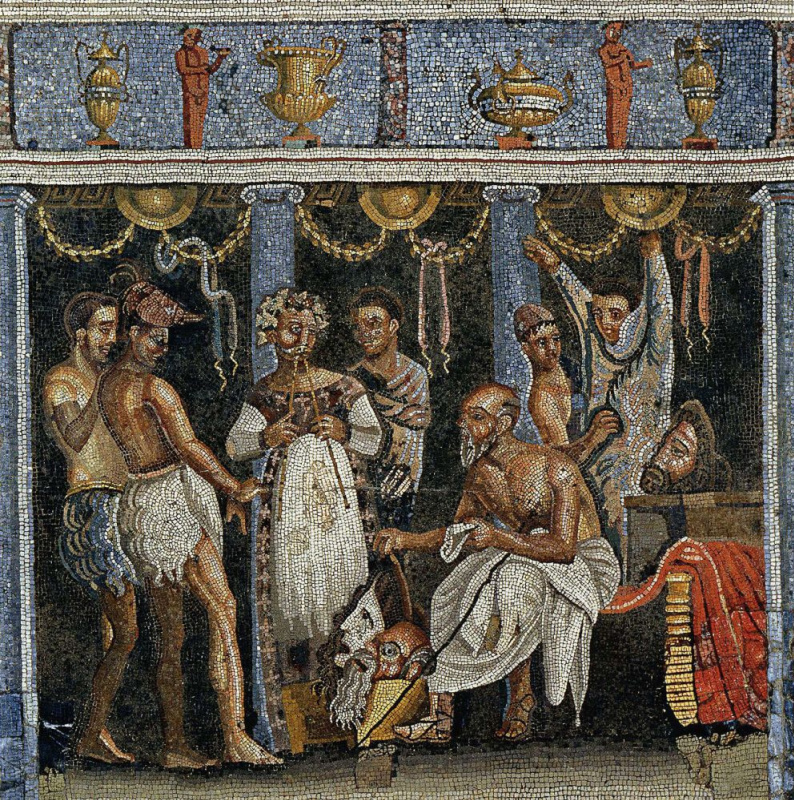
Roman mosaic
, The Actors Preparing for Performance or a Rehearsal for a Satire, about 62−79 A.D. The Naples National Archaeological Museum.
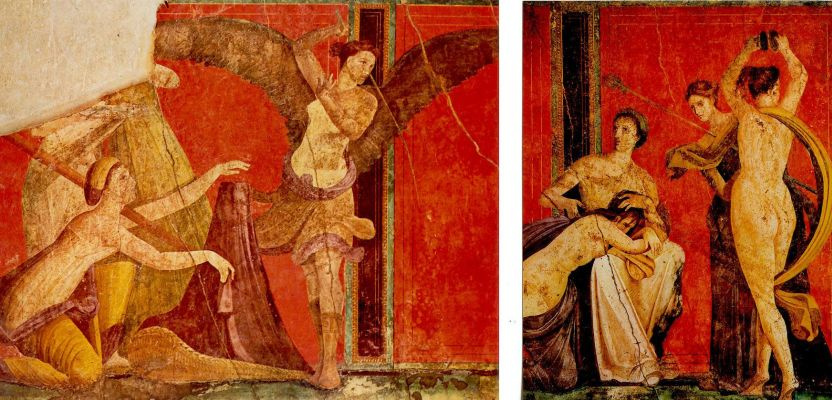
The frescos from the Villa of the Mysteries on the outskirts of Pompeii best survived after the eruption of Mount Vesuvius in 79. Customers apparently preferred red color which later was called Pompeian Red.
Flight of angels in Heavens
True artists by no means could avoid a blue color and quite often it was used in the early Christian mosaics and miniatures; though, before XII century it was not considered equally with red, white and black colors.In XIII century everything changed. At last artists learnt how to make a blue paint of lapis-lazuli, cobalt and indigo. A blue color gained popularity and upper class favored it. Painters began inventing different hues of a blue color and it became one of the most appreciated in the Medieval art. The sky had been dark or white then it became blue and the sea green in old engravings gained different shades of a blue color.
Lamentation of Christ. Scenes from the life of Christ
1306, 185×200 cm
Eyeing of the colors symbolizing divine nature and royalty spiritualized people of the Medieval times filling them with pietistic thoughts. Then everybody understood that the endless blue sky was the only place for supreme forces, a symbol of another everlasting world inextricably intertwined with revelation and divine inarticulacy.
The blue color having been faint and gloomy for a long time progressively became brighter on brushes of the artists and turned into vibrant and cheerful. Frescos in a lot of churches devoted to the Mother of God was saturated with azure. The Mother of God was depicted dressed in blue robes both because she ascended to Heavens and because the blue color was thought to precede the black one, the color of mourning. The blue color combined earthly and heavenly, embodied a spiritual chastity and virtue of the Mother of God.

Ultramarine splendor
Natural ultramarine was used in the West European oil paintings rather late, at the turn of XIV — XV centuries. Though, the Holy Mary deserves better. From now on the God Mother’s robes should be painted only with the valuable ultramarine. However, artists used it only when they were commissioned to paint artworks. Thus a lot of paintings in XV — XVI centuries were paid for the number of figures in canvases and the amount of ultramarine needed for painting was paid for in advance.For example, there was the unfinished painting by Michelangelo, which had not been finished only because the customer failed to pay for lapis-lazuli required for painting of the Holy Mother’s robes. Performing the contract Michelangelo designed the entire color composition around the Holy Mother’s figure, which should be painted in a vibrant blue color but after he had learnt about the lack of the blue paint he stopped painting it.
A blue paint was prevalently made of indigoferous plants though it was short lasting and did not produce the needed color and shade, which was highly valued by clergymen. Lapis-lazuli (natural ultramarine) was the best. Lapis — lazuli could be traded for gold with the rate 1:1. After processing of 100 grams of the stone the outcome was only 3 grams of the pigment.
Ultramarine of low quality was used in Byzantine manuscripts in VII century and for the Medieval miniatures. The manuscripts of XV — XVI centuries were really precious because of the pigments made of precious and semiprecious minerals. For instance a water based paint with the ultramarine pigment was used for painting the sky.
In the Medieval France and Italy the amount of a blue paint was controlled by the State. The cheaper Prussian blue made of a blue azurite pigment was the most popular in the Medieval Germany. Though the color was colder. That was the reason why the Prussian blue was banned for decoration of the altarpieces and icons in Florence in XIV century. Only ultramarine was allowed and it had been the most preferable for some further centuries.
Madonna with singing angels,
1477, 135 cm
The Prussian blue was banned for decoration of the altarpieces and icons in Florence in XIV century.
One of the Dutch galaxy of talented artists Johannes Vermeer (1632 — 1675) preferred to use this valuable pigment. At the start of his career the artist realized that he could achieve the unique color of the day light adding ultramarine pigment even in a black paint. No artist could compete with him.
Rebellious Palette
In the course of time colors have lost their symbolic meaning though they are still the means of expression by artists feelings and emotions of their characters.Spanish artist of XVI century El Greco (1541 — 1614) made active use of the emotional effect of all the hues of the blue color. The artist preferred exciting transparent steel blue color with which he conveyed emotions of his characters and created the atmosphere of mysticism in his artworks.
View Of Toledo
1599, 121.3×108.6 cm
Expressive blue color was a peculiar feature of the color range used by Vincent van Gogh, a Dutch painter (1853 — 1890). His artworks are overfilled with alarm and perturbation be it a portrait, still-life or genre scene. In his painting the Starry Night the artist with the contrast of chrome and blue thickened to black expressed the commotion of his spirit and fear verging on despair.

The other crazy man of genius Mikhail Vrubel was fascinated by a dark-blue color. Solitude and despair of the Devil against blue background is informing the artwork.
Demon sitting
1890, 116.5×213.8 cm
A blue color symbolizing solitude and sadness was introduced into the history of the world culture by the oeuvre of Pablo Picasso, especially the so-called Blue Period (1901 — 1904) produced by the artist. The artist was seized by the themes of age and death, melancholy and sadness. The emotional azure color is dominating in the artworks of this period. The artist is obviously overwhelmed with bitterness, guilt and death. These somber works were inspired by the suicide of his friend Carlos Casagemas, a painter. Picasso himself later recalled, "I started painting in blue when I learned of Casagemas’s death".
Away from vanities of the world
No doubt, colors affect our subconscious mind. Dark blue could inspire our anxiety, frustration and sadness. Though, being lighter it reveals serenity. Symbolists adored this blue color due to its very peculiar feature associated with the water surface and endless sky away from vanities of the world. As the result, the Symbolist Artist Association appeared in the Russian artistic life in the early XX century (its members included Pavel Kuznetsov, Martiros Saryan, Nikolai Sapunov, Sergei Sudeikin, Petr Utkin, Artur Fonvizen and Nikolai Krymov and others).Towards the Epoch of the Great Spiritual
Since the German Romanticism time a blue color has been considered a symbol of spiritual aspiration of a person and of a spirit as a whole. On the eve of World War I Wassily Kandinsky and Franz Marc had high hopes for the further Epoch of the Great Spiritual, which should consolidate all movements in art and culture. The Blue Rider on the cover of the Almanach (1911) designed by Kandinsky embodied the universal concept of painting for the artists. The group founded by Kandinsky had the same name. Marc had his own theory of colors having special spiritual sense each; for example, according to his theory a blue color implied the male and austere principles.In search of ideal
The gorgeous blue has haunted the mind of the artists in XX century. Yves Klein intended to find and absolute and perfect color embodying spiritual and infinite. According to him the vibrant sky in the Giotto’s paintings inspired him and the color assisted him in learning immateriality.He began his research in the early 50s. In 1957 in Milan he produced 11 monochromes of the same size. It was famous Yves Klein Blue (International Klein Blue or IKB) the formula of which was patented by the artist in 1960.

Ancient god and at the same time Messiah lit with the divine radiance. The portrait of the artist, a colleague and a member of the New Realists group in blue color IKB.
Yves Klein, the Arman, (1962) The Pompidou Centre, Paris.
Yet, the unofficial palette free of patents and available for artists to use it recklessly has not become less opulent. The blue color has an infinite variety of hues.
The cover illustration: Pablo Picasso. The Blue Nude
, 1902.






